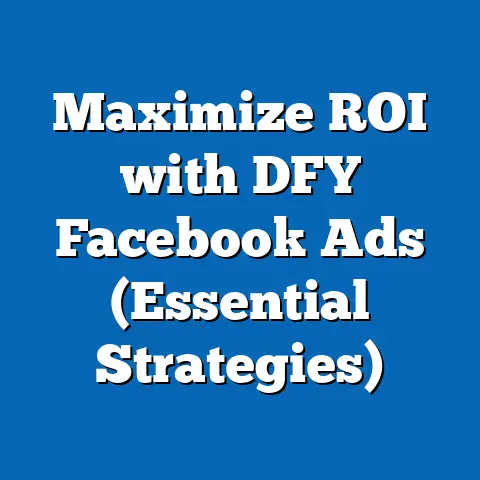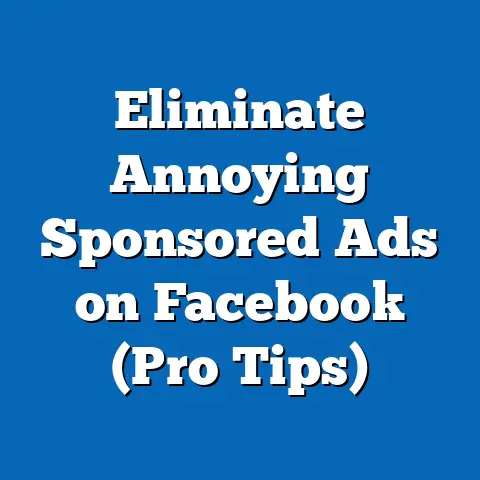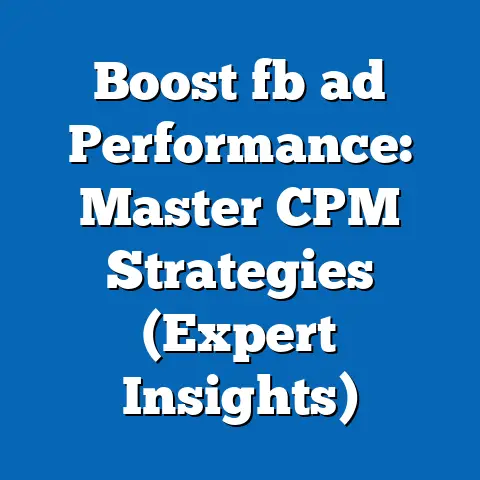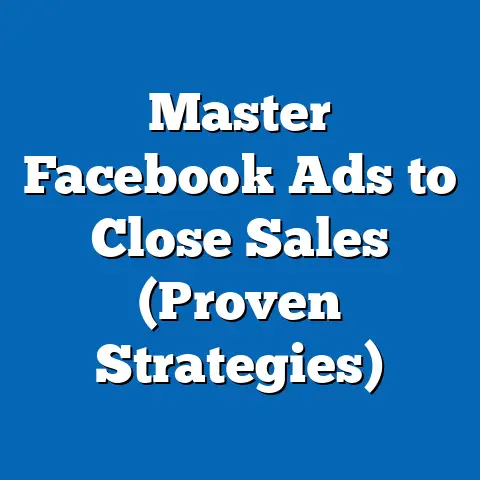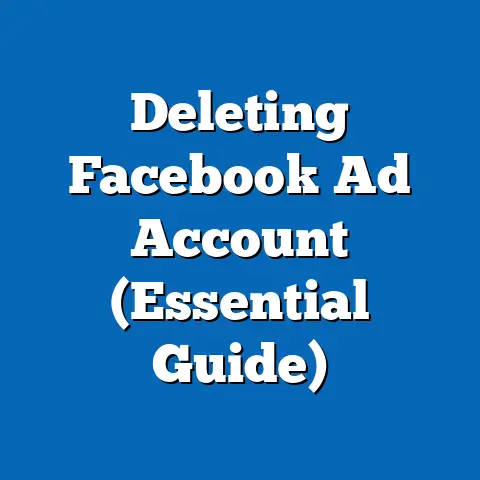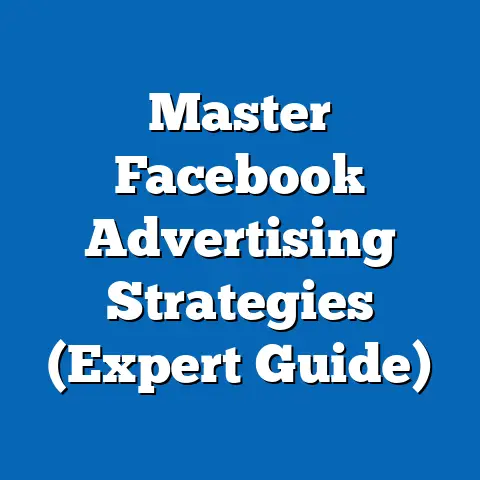“Fix ‘Status Not Delivering’ on Facebook Ads (Pro Tips)â€
Imagine waking up to a beautiful, sunny day. The sky is clear, the birds are singing, and you feel optimistic about everything you’re about to do. This is how it feels when you launch a Facebook ad campaign – full of promise and potential. But just as a sunny day can suddenly turn stormy, your Facebook ad campaign can hit a snag, leaving you with the dreaded “Status Not Delivering” message. Understanding the elements that affect ad delivery is crucial, much like understanding weather patterns helps us prepare for sudden storms.
Understanding Facebook Ads Delivery Status
Let’s dive into the basics. What does “Status Not Delivering” actually mean, and why should you care?
What Does ‘Status Not Delivering’ Mean?
In the Facebook Ads Manager, the “Status Not Delivering” message indicates that your ad is not actively being shown to your target audience. This doesn’t necessarily mean your ad is rejected or disapproved; it simply means it’s not running. This can happen for a variety of reasons, which we’ll explore in detail.
From my experience, this status can be incredibly frustrating. You’ve invested time and effort into creating your ad, defining your audience, and setting your budget, only to see it stall before it even gets started. It’s like preparing a delicious meal and then finding out the oven isn’t working!
The significance of ad delivery status is paramount because it directly impacts your campaign goals and objectives. If your ads aren’t delivering, you’re not reaching your target audience, you’re not generating leads, and you’re certainly not making sales. It’s a standstill that needs immediate attention.
Common Reasons for Status Not Delivering
Several factors can trigger the “Status Not Delivering” message. Here are some of the most common culprits:
- Budget Constraints: Your daily or lifetime budget might be too low to compete in the ad auction, especially if your target audience is broad or highly competitive.
- Audience Targeting Issues: Overly narrow targeting can restrict your reach, preventing your ad from being shown. Conversely, targeting too broadly can lead to poor performance and, eventually, Facebook throttling your delivery.
- Ad Creative Disapproval: If your ad violates Facebook’s advertising policies, it will be disapproved and won’t deliver. This could be due to misleading content, prohibited products, or violations of community standards.
- Low Bid: Your bid might be too low to win ad auctions, especially if other advertisers are bidding higher for the same audience.
- Scheduling Issues: Your ad might be scheduled to run only during specific times, and it’s currently outside of those hours.
- Ad Fatigue: If your audience has seen your ad too many times, they may become desensitized to it, leading to a decrease in engagement and, eventually, delivery.
- Technical Glitches: Occasionally, there might be technical issues on Facebook’s end that prevent ads from delivering.
Personal Anecdote: I once had a campaign that suddenly stopped delivering. After hours of troubleshooting, I discovered that I had accidentally set the end date for the campaign to the previous day! A simple mistake, but it cost me valuable time and potential leads.
These are just a few of the potential reasons why your ad might not be delivering. The key is to systematically investigate each possibility until you identify the root cause.
The Importance of Monitoring Delivery Status
Monitoring your ad delivery status is not just a good practice; it’s essential for successful Facebook advertising. Here’s why:
- Early Detection: By regularly checking your ad status, you can identify issues early on and take corrective action before they significantly impact your campaign performance.
- Cost Optimization: If your ads aren’t delivering, you’re essentially wasting your budget. Monitoring allows you to reallocate resources to more effective campaigns or adjust your strategy to improve delivery.
- Improved ROI: By ensuring your ads are consistently delivering, you’re maximizing your reach and engagement, ultimately leading to a better return on investment.
- Data-Driven Decisions: Monitoring delivery status provides valuable data that can inform your future advertising decisions. You can identify patterns, trends, and potential issues that can help you optimize your campaigns for better results.
Think of it like a doctor monitoring a patient’s vital signs. If the vital signs are abnormal, the doctor can investigate the underlying cause and take appropriate action to restore the patient’s health. Similarly, monitoring your ad delivery status allows you to diagnose and treat any issues that are preventing your ads from performing optimally.
Key Takeaway: Regularly monitor your ad delivery status in Facebook Ads Manager. Early detection and prompt action can save you time, money, and frustration.
Next Step: Set a reminder to check your ad delivery status at least once a day, or more frequently if you’re running time-sensitive campaigns.
Diagnosing the Problem
Now that you understand the importance of monitoring your ad delivery status, let’s move on to the next crucial step: diagnosing the problem.
Analyzing Campaign Settings
The first step in troubleshooting a “Status Not Delivering” issue is to carefully analyze your campaign settings. This involves reviewing several key areas to identify any potential problems.
- Campaign Objective: Ensure that your campaign objective aligns with your overall marketing goals. If you’re trying to generate leads but your objective is set to “Brand Awareness,” your ads might not be optimized for lead generation, leading to poor performance and eventual delivery issues.
- Campaign Budget: As mentioned earlier, your budget plays a significant role in ad delivery. If your budget is too low, your ads might not be able to compete in the ad auction. Consider increasing your budget to see if it improves delivery.
- Campaign Schedule: Double-check your campaign schedule to ensure that your ads are set to run during the desired times. If your schedule is too restrictive, your ads might not be delivering consistently.
- Ad Set Budget: Similar to campaign budgets, ad set budgets can also impact delivery. Ensure that your ad set budgets are sufficient to reach your target audience.
- Ad Set Schedule: Review your ad set schedule to ensure that your ads are running during the times when your target audience is most active.
- Ad Set Audience: This is a critical area to analyze. Make sure your target audience is well-defined and not overly narrow. Use Facebook’s Audience Insights tool to get a better understanding of your audience demographics, interests, and behaviors.
Pro Tip: When reviewing your audience settings, pay close attention to the estimated audience size. If your audience is too small, consider expanding it by adding more interests or broadening your geographic targeting.
I remember working with a client who was targeting a very specific niche audience. Their ads weren’t delivering, and after analyzing their audience settings, I realized that their estimated audience size was only a few thousand people. By expanding their audience to include related interests, we were able to significantly improve their ad delivery and generate more leads.
Reviewing Ad Creative
Your ad creatives are another potential source of delivery issues. Facebook has strict advertising policies that you must adhere to. If your ads violate these policies, they will be disapproved and won’t deliver.
- Ad Policy Compliance: Familiarize yourself with Facebook’s advertising policies and ensure that your ads comply with all guidelines. Pay close attention to prohibited content, misleading claims, and offensive language.
- Image Quality: Use high-quality images and videos that are visually appealing and relevant to your target audience. Avoid using blurry or pixelated images, as they can negatively impact your ad performance.
- Ad Copy: Write clear, concise, and engaging ad copy that highlights the benefits of your product or service. Avoid using clickbait headlines or deceptive language.
- Call to Action: Include a clear and compelling call to action that tells your audience what you want them to do. Use action-oriented language such as “Shop Now,” “Learn More,” or “Sign Up Today.”
Personal Anecdote: I once had an ad disapproved because it contained a before-and-after image that violated Facebook’s policy against promoting unrealistic body images. I had to replace the image with a more subtle one to get the ad approved.
Pro Tip: Use Facebook’s Ad Preview tool to see how your ads will look on different devices and placements. This will help you identify any potential issues with your ad creatives before you launch your campaign.
Understanding Audience Targeting
Effective audience targeting is crucial for successful Facebook advertising. If your targeting is off, your ads might not be reaching the right people, leading to poor performance and delivery issues.
- Audience Definition: Clearly define your target audience based on demographics, interests, behaviors, and other relevant factors.
- Audience Size: Ensure that your audience size is large enough to allow your ads to deliver effectively. As a general rule, aim for an audience size of at least 1,000 people.
- Audience Overlap: Avoid targeting multiple audiences that overlap significantly. This can lead to ad fatigue and decreased performance.
- Lookalike Audiences: Consider using Facebook’s Lookalike Audiences feature to reach new people who are similar to your existing customers. This can be a highly effective way to expand your reach and improve your ad delivery.
- Custom Audiences: Leverage Custom Audiences to target people who have already interacted with your business, such as website visitors, email subscribers, or app users. This can be a great way to re-engage your audience and drive conversions.
Pro Tip: Use Facebook’s Audience Insights tool to get a better understanding of your audience demographics, interests, and behaviors. This can help you refine your targeting and improve your ad delivery.
I once worked with a client who was struggling to reach their target audience. After analyzing their audience settings, I discovered that they were targeting a very broad audience with little relevance to their product. By refining their targeting to focus on people with specific interests and behaviors, we were able to significantly improve their ad delivery and generate more leads.
Key Takeaway: Carefully analyze your campaign settings, ad creatives, and audience targeting to identify any potential issues that might be causing your ads to not deliver.
Next Step: Review your current Facebook ad campaigns and systematically analyze each of these areas to identify any potential problems.
Pro Tips to Fix ‘Status Not Delivering’
Now that you’ve diagnosed the problem, let’s move on to the fun part: fixing it! Here are some pro tips that I’ve learned over the years to help you get your ads back on track.
Adjusting Budgets and Bids
One of the most common reasons for ads not delivering is an insufficient budget or bid. Here’s how to adjust them for optimal performance:
- Increase Your Budget: If your daily or lifetime budget is too low, consider increasing it. This will give your ads more opportunities to be shown to your target audience. I’ve found that increasing the budget by even 20-30% can sometimes make a significant difference.
- Adjust Your Bid Strategy: Facebook offers several bid strategies, including lowest cost, cost cap, and target cost. Experiment with different bid strategies to see which one works best for your campaign.
- Lowest Cost: This strategy aims to get you the most results for your budget. However, it might not be the best option if you’re targeting a highly competitive audience.
- Cost Cap: This strategy allows you to set a maximum cost per result. It can be a good option if you want to control your costs while still maximizing your results.
- Target Cost: This strategy aims to achieve a specific cost per result. It’s a good option if you have a clear understanding of your target cost and want to optimize your campaign accordingly.
- Manual Bidding: If you’re comfortable with manual bidding, you can set your own bids for each ad auction. This gives you more control over your costs but requires more monitoring and optimization.
- Lowest Cost: This strategy aims to get you the most results for your budget. However, it might not be the best option if you’re targeting a highly competitive audience.
- Cost Cap: This strategy allows you to set a maximum cost per result. It can be a good option if you want to control your costs while still maximizing your results.
- Target Cost: This strategy aims to achieve a specific cost per result. It’s a good option if you have a clear understanding of your target cost and want to optimize your campaign accordingly.
Personal Anecdote: I once had a campaign that was delivering well initially, but then suddenly stopped. After analyzing the performance data, I realized that my cost per result was gradually increasing. By switching from the “lowest cost” bid strategy to the “cost cap” strategy, I was able to stabilize my costs and get my ads back on track.
Pro Tip: Don’t be afraid to experiment with different budget levels and bid strategies. The key is to find the sweet spot that allows you to reach your target audience effectively without breaking the bank.
Revising Target Audiences
As we discussed earlier, audience targeting is crucial for successful Facebook advertising. If your ads aren’t delivering, it might be time to revise your target audiences.
- Expand Your Audience: If your audience is too narrow, consider expanding it by adding more interests or broadening your geographic targeting.
- Refine Your Audience: If your audience is too broad, consider refining it by adding more specific interests or behaviors.
- Use Lookalike Audiences: As mentioned earlier, Lookalike Audiences can be a highly effective way to reach new people who are similar to your existing customers.
- Experiment with Different Audience Segments: Try segmenting your audience based on demographics, interests, behaviors, or other relevant factors. This will allow you to tailor your ads to specific groups of people and improve your ad delivery.
- Exclude Overlapping Audiences: If you’re targeting multiple audiences, make sure they don’t overlap significantly. This can lead to ad fatigue and decreased performance.
Pro Tip: Use Facebook’s Audience Insights tool to get a better understanding of your audience demographics, interests, and behaviors. This can help you refine your targeting and improve your ad delivery.
I once worked with a client who was targeting a very specific demographic group. Their ads weren’t delivering, and after analyzing their audience settings, I realized that they were excluding a large segment of their potential customers. By removing some of the demographic restrictions, we were able to significantly improve their ad delivery and generate more leads.
Improving Ad Quality
High-quality ads are more likely to be approved by Facebook and deliver effectively to your target audience. Here are some best practices for optimizing your ad creatives:
- Use High-Quality Images and Videos: As mentioned earlier, use visually appealing images and videos that are relevant to your target audience.
- Write Compelling Ad Copy: Your ad copy should be clear, concise, and engaging. Highlight the benefits of your product or service and tell your audience what you want them to do.
- Include a Clear Call to Action: Your call to action should be action-oriented and tell your audience exactly what you want them to do.
- A/B Test Your Ads: A/B testing involves creating multiple versions of your ad with different headlines, images, or calls to action. This allows you to test which versions perform best and optimize your ads accordingly.
- Follow Facebook’s Advertising Policies: Make sure your ads comply with all of Facebook’s advertising policies. This will help you avoid ad disapprovals and ensure that your ads deliver effectively.
Personal Anecdote: I once had a campaign that was performing poorly. After A/B testing different headlines, I discovered that a simple change in wording significantly improved my click-through rate. This highlights the importance of continuous testing and optimization.
Pro Tip: Use Facebook’s Ad Preview tool to see how your ads will look on different devices and placements. This will help you identify any potential issues with your ad creatives before you launch your campaign.
Utilizing Facebook Support Resources
If you’ve tried all of the above tips and your ads are still not delivering, it might be time to reach out to Facebook support for help.
- Facebook Help Center: The Facebook Help Center is a comprehensive resource that contains answers to many common questions about Facebook advertising.
- Facebook Community Forums: The Facebook Community Forums are a great place to connect with other advertisers and get help with your questions.
- Facebook Support Chat: Facebook offers a support chat feature that allows you to communicate directly with a Facebook support representative.
- Facebook Business Manager Support: If you’re using Facebook Business Manager, you can access dedicated support resources that are tailored to your specific needs.
Pro Tip: When contacting Facebook support, be prepared to provide detailed information about your campaign, including your campaign settings, ad creatives, and audience targeting. This will help the support representative diagnose the problem and provide you with the best possible solution.
I once had a technical issue with my Facebook ad account that I couldn’t resolve on my own. After contacting Facebook support, they were able to identify the problem and fix it within a few hours. This highlights the importance of leveraging Facebook’s support resources when you’re facing challenges.
Key Takeaway: Adjust your budgets and bids, revise your target audiences, improve your ad quality, and utilize Facebook support resources to fix “Status Not Delivering” issues.
Next Step: Implement these pro tips in your Facebook ad campaigns and monitor your results closely.
Case Studies and Examples
Let’s take a look at some real-life examples of businesses that faced the “Status Not Delivering” issue and how they resolved it.
Lessons Learned
The key takeaways from these case studies are:
- Audience Targeting Matters: Make sure your target audience is well-defined and not overly narrow.
- Ad Quality is Crucial: Use high-quality images and videos and write compelling ad copy.
- Bid Strategy is Important: Experiment with different bid strategies to see which one works best for your campaign.
- Continuous Optimization is Essential: Continuously monitor your ad performance and make adjustments as needed.
Key Takeaway: Continuous learning and adaptation are essential for success in Facebook advertising.
Next Step: Review these case studies and identify any lessons that you can apply to your own Facebook ad campaigns.
Conclusion
Navigating the world of Facebook ads can sometimes feel like predicting the weather. One minute, your campaign is running smoothly, and the next, you’re facing the dreaded “Status Not Delivering” message. But just as understanding weather patterns can help you prepare for sudden storms, understanding the factors that affect ad delivery can help you troubleshoot and resolve this issue.
Recap of Key Points
Throughout this article, we’ve covered several key points:
- Understanding the “Status Not Delivering” Message: We defined what this status means and why it’s important to monitor it.
- Diagnosing the Problem: We explored how to analyze your campaign settings, ad creatives, and audience targeting to identify potential issues.
- Pro Tips to Fix the Issue: We shared actionable tips on adjusting budgets and bids, revising target audiences, improving ad quality, and utilizing Facebook support resources.
- Case Studies and Examples: We presented real-life examples of businesses that faced the “Status Not Delivering” issue and how they resolved it.
Encouragement for Continuous Improvement
Remember, Facebook advertising is an ongoing process of learning, testing, and optimization. Don’t get discouraged if you encounter challenges along the way. Instead, use these challenges as opportunities to learn and improve your skills.
Just as a gardener continuously tends to their plants, you should continuously tend to your Facebook ad campaigns. Monitor your performance, make adjustments as needed, and never stop learning.
Call to Action
Now, I’d love to hear from you! What are your experiences with Facebook ads? Have you ever faced the “Status Not Delivering” issue? What tips do you have for overcoming delivery issues? Share your thoughts and experiences in the comments below. Together, we can learn from each other and become better Facebook advertisers.

